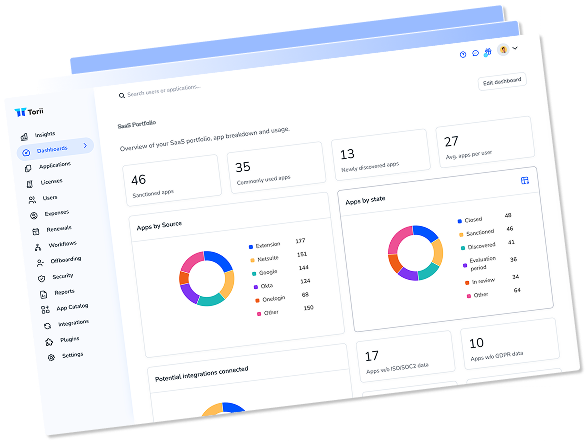Key Points:
- Just like a conductor keeps a symphony together, a CLM keeps your team accountable and on pace with contracts through each stage of the contract management process
- If you’re looking for a holistic SaaS Management solution that manages contracts but also discovers shadow IT, offers SaaS-driven insights, and automates admin tasks like onboarding, offboarding, and license management—then check out Torii
- Quick Links
Managing contracts without a system is like an orchestra trying to play Beethoven’s Ninth Symphony without a conductor. You’ve got the strings, the brass, the woodwinds, and the percussion all trying to hit the right notes, but without guidance, it quickly descends into cacophony.
Enter Contract Lifecycle Management (CLM). Just as a conductor brings order to a symphony, guiding every musician from the first note to the last, a CLM tool orchestrates every aspect of your contracts, from creation to renewal. It turns contract management from a jarring composition into a harmonious masterpiece.
Ready to fine-tune your symphony? Let’s dive into the crescendo of contract management. The curtain rises, and our journey into the world of contracts begins.
Imagine trying to explain an orchestral score to someone who’s only ever heard pop music. It’s complicated, right? Let’s unravel that complexity by getting to know our maestro for today. Here is everything you need to know about Contract Lifecycle Management (CLM).
What is Contract Lifecycle Management?
So, what exactly is CLM? In the simplest of terms, it’s like the score for our orchestra. CLM is a methodical approach to managing a contract from its inception to its retirement or completion. It’s the step-by-step dance we follow, ensuring that every contract is handled with visibility and confidence.
The Role of a CLM in Contract Management
But what about the role of contract lifecycle management software in all of this? It’s the conductor ensuring each section of the orchestra is in sync, following the score, and collaborating fluidly together. In the business world, that’s ensuring each contract is drafted, negotiated, signed, executed, and managed effectively. A CLM solution is there to make sure that you’re not just reacting to contract matters as they arise, but rather you have a proactive strategy—keeping all responsible parties on the same beat.
The 4 Stages of a Contract’s Lifecycle
Just as a symphony has movements, a contract has stages. From drafting the contract to negotiating terms and all the way through to signing, executing, and managing the contract. Then there’s the renewal or termination of the contract. Each stage is a crucial part of the overall performance. Understanding these stages, their order and their owners is critical to prevent headaches, wasted costs, and liability
Let’s take a moment and explore the movements of our contract management process. Each stage of the contract is managed by the CLM solution.
1. Create Contracts
It’s during this phase that the goals of the contract are defined and agreed upon, and templates take center stage. Contracts must be consistent, reliable, and fully vetted before they are used. That level of scrutiny is impossible without relying on templates. They lay out the general terms and conditions, set the standards for legal compliance, and significantly reduce the time and effort involved in drafting new contracts from scratch.
Many CLMs have basic automation capabilities for the creation phase. This ensures consistency and reduces the risk of errors. It also facilitates better collaboration among stakeholders, as everyone has access to the same updated information.
In other words, this tool streamlines the entire process, allowing you to create precise, compliant contracts more quickly and efficiently.
2. Negotiate Contracts
Negotiation is the action-packed phase of the contract lifecycle. Much like a strategic chess match, it requires foresight, diplomacy, and shrewd decision-making.
Best Practices in Contract Negotiation Process
Effective contract negotiation requires strategic planning, keen perception, and excellent communication skills. Here are some best practices to make your contract negotiations as successful as possible:
- Prepare Thoroughly: Preparation is a prerequisite for successful negotiation. Understand the contract in detail, determine what you want to achieve, and know the limits of what you can accept. For example, if you are renewing a SaaS tool, make sure you know exactly how critical that app really is.
- Unfortunately, many professionals find themselves grappling with surprise renewals. Make sure you have a notification system in place to make sure nothing slips under the radar.
- Unfortunately, many professionals find themselves grappling with surprise renewals. Make sure you have a notification system in place to make sure nothing slips under the radar.
- Understand Your Counterpart: To engage effectively in negotiations, you should know the other party’s needs, interests, and pressure points. Are economic times tough for you? There’s a good chance the same is true for them. If your counterparty is battling against high churn, that becomes leverage.
- Keep Communication Open and Transparent: A negotiation is a two-way street. Encourage open communication to understand the other party’s point of view.
- Be Flexible: Sometimes, things don’t go as planned. Just as a good director knows when to adjust a scene for a better outcome, you should be prepared to compromise and adapt your strategy if it serves the larger goals.
- Document Everything: Record every agreement, change, and decision made during the negotiation process. This helps prevent misunderstandings and disagreements later on, ensuring a smooth process.
By incorporating these best practices into your contract negotiation process, you’ll be well on your way to crafting agreements that benefit all parties involved.
3. Contract Review
It’s not uncommon for teams to get a little careless at this stage. After the negotiation, it’s easy to let focus shift to other matters, but ensure you stay vigilant! You’re on the home stretch of this marathon—this is where the document is inspected thoroughly to ensure everything is in order.
Importance of Clause Review in Contracts
You can think of your contract like a game of Jenga—a contract is a careful balance of terms and conditions, just like a tower of Jenga blocks. A single misplaced clause can jeopardize the whole agreement. That’s why clause review is crucial. It ensures that all aspects of the contract are legally sound, beneficial, and in alignment with your business objectives.
Often, the CLM software will aid in this critical step by helping identify any potentially shaky clauses and mitigate the risk of contractual disputes down the line. It does this by highlighting key clauses, tracking any changes made during negotiation, and maintaining an organized archive for easy reference.
4. Contract Administration and Renewal
We’re now at the final act: contract administration and renewal – where performance meets evaluation.
The contract renewal process requires thorough review, assessment of terms, and a crucial decision – does the contract merit an extension, or is it time to part ways? It’s a phase that demands strategic thinking and prudent decision-making, as the implications can significantly impact your business operations.
CLM software will send renewal alerts and automate portions of the renewal process. However, the legwork of understanding whether the contract is paying off will usually require further research.
What are the Key Features of Contract Management Software?
So, we’ve understood the rhythm and movements of our contract symphony. Now, let’s take a look at the individual “instruments” that help create that overarching experience. These are the key features of your contract management platform.
Workflow Automation
First up—workflow automation. From automatic reminders for key contract dates to streamline the creation process, workflow automation ensures every part of your contract management runs as smoothly as possible.
Repository for Managing Contracts
Next, we have the repository, our System of Record. With a centralized, searchable repository, all your contracts are well-organized and easily accessible for fast reference.
Visibility Features for Stakeholders
Often there are multiple parties involved in the contract lifecycle management process. These stakeholders need visibility. This is to ensure each stakeholder knows exactly what’s happening with your contracts when it’s happening, and (importantly) why.
Integration Features (Salesforce, DocuSign)
Finally, we have the integration features, a critical way to include external software solutions within your process. From Salesforce for your CRM needs to DocuSign for seamless, legal e-signatures, integration features ensure your contract management software plays in perfect rhythm with your existing tech stack.
Where Contract Lifecycle Management Systems Fall Short
The trick with a CLM is that it does provide structure and order for all your contracts in one place. However, there are limitations and blind spots that often go overlooked.
One of the top causes for concern with a contract management system is the visibility of your existing software.
Shadow IT has exploded in use due to the ease of adoption for SaaS applications. Unfortunately, these “shadow expenses” and corresponding contracts will spawn and spread without finance or procurement having any visibility. Often, companies don’t know an app exists until they see a charge go through or a department head mentions an upcoming renewal.
Unfortunately, CLMs provide contract structure but don’t offer the kind of visibility and control that decisions depend on.
Similarly, a contract management system won’t provide insights about license utilization and usage trends for SaaS apps. Without these basic insights, procurement teams don’t have the kind of leverage they need for effective negotiation.
For all the good a CLM offers, it does also have limits. To help compensate for those shortcomings, you can look at a SaaS Management Platform to help fill the gaps.
How a SaaS Management Platform (SMP) Helps Fill the CLM Software Gaps
According to the Gartner Market Guide for SaaS Management Platforms, an SMP is a complementary system that allows you to operationalize your entire cloud application stack:
- Discover
- Manage
- Automate
- Optimize
- Protect
- Govern
With these kinds of capabilities, you can improve the visibility and operationalization of your entire SaaS—not just the contracts.
Torii, a leading SaaS Management Platform, has a unique set of capabilities to help with the contract lifecycle management process.
How Torii Improves Contract Management
Torii features a unique user role just for procurement.
Learn more about Torii for Procurement
Overview of Torii’s Automatic Discovery and Software Inventory Capabilities
Torii’s automatic discovery feature is the key capability that makes everything else possible. It automatically detects all your software and SaaS applications through a variety of data sources, including:
- CASB. Parses data from traffic logs.
- Web proxy. Parses data from traffic logs.
- Single sign-on (SSO). Parses data from authentication logs.
- API. A unique setup for and between SaaS apps; breadth and depth vary by tool and app.
- Agent or browser extension. Monitors and logs web activity.
- Expenses/accounts payable. Parses data from transactions.
With this discovery engine, it creates a dynamic list of apps in your SaaS system of record. Including usage rates, lifecycle stage, app owners, and more. This system of record becomes the perfect place to upload contract data so you always have an audit-ready record of SaaS terms and conditions.
Torii also includes a designated contract module.
How the Contracts Module Enhances the Existing Renewal Calendar Feature
The contracts module feature is full of features and a high-level overview of the state of your SaaS contracts. This dynamic view gives you the TL;DR status on all your contracts, all in one place.
Contracts Table with Smart Filters: The Contracts Table feature with smart filters allows you to sift through and find exactly what you need in a contract.
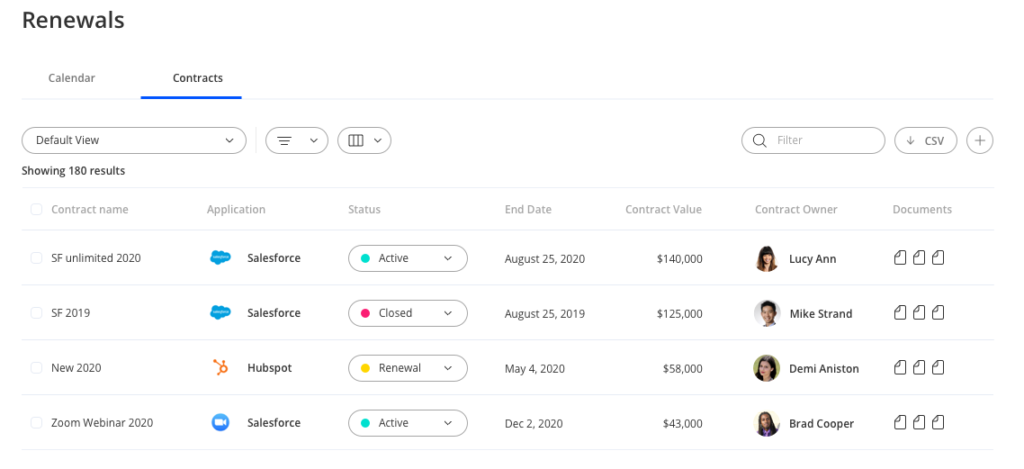
Multiple Contracts per Application: Got more than one contract per application? No problem, Torii can handle it.
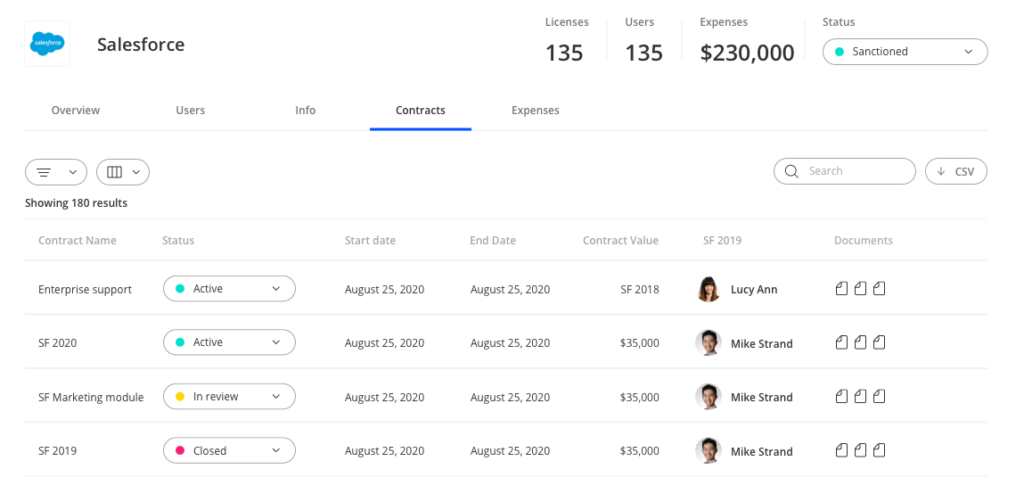
Full Contract Lifecycle Maintenance: Torii maintains the full contract lifecycle—each step of the way.
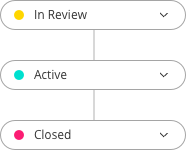
Custom Contract Fields: With fully customizable contract fields, you get to control what data you want to store and manage.
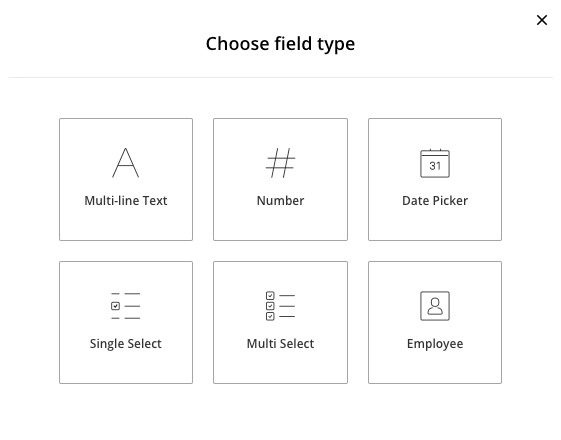
Historical Record Keeping: With Torii, every contract you’ve ever managed is stored for reference.
Powerful workflow integrations: use contract data as personalization tokens within automated workflows. This lets you set automated workflows for advanced notifications or request app data from application owners.
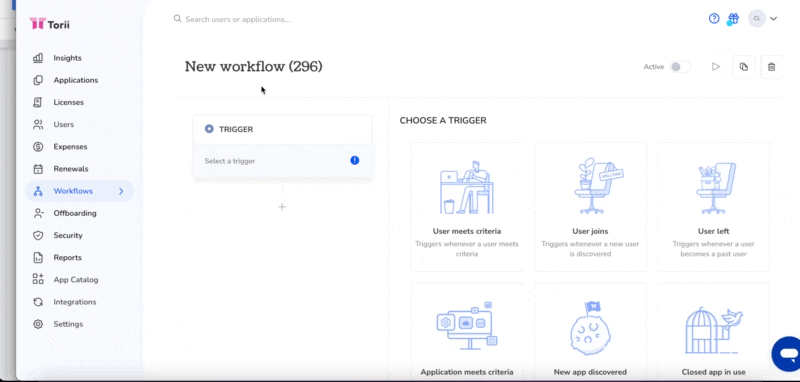
Conclusion
Every stage of the contract process is critical to the overall success and optimization of your organization. From Contract creation to the review phase. Your process must be efficient and replicable and provide visibility to stakeholders like finance, procurement, or the legal team.
A CLM can help you establish a process, save money, and reduce risk. But, it cannot provide you with the necessary visibility and insight into usage trends, license utilization, or shadow IT discovery. By bringing together the capabilities of a SaaS Management Platform with a Contract Lifecycle Management system, you’ll have the tools to succeed.
Curious? Request a demo of Torii—including its Contract Management features, to learn more.

